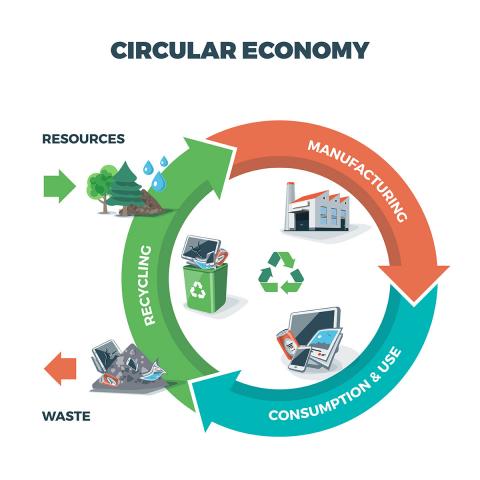Have you heard of Extended Producer Responsibility (EPR)? It’s a special set of government laws to make sure that companies take responsibility for what happens to their products when they reach the end of their useful life. EPR reduces waste by encouraging manufacturers, distributors, and retailers to put plans in place for how their products are disposed of.
EPR laws focus on specific items such as small appliances and power tools. The laws require companies that make or sell these products to oversee a plan for recycling them in an eco-friendly way instead of just throwing them in a landfill. With the introduction of EPR laws, manufacturers get goals they need to meet. Then generally, to reach those goals, they must start recycling programs.

British Columbia’s first EPR program started in 1994, when the Post-Consumer Paint Stewardship Program Regulation was passed. In response, producers introduced paint collection depots for residents across the province (Product Care Recycling). Since then, a number of different products have been added to BC’s EPR Regulation. Products in the regulation include small appliances, power tools, beverage containers, tires, light bulbs, batteries, electronics, packaging and paper, and used oil.
Here are some further insights into how EPR reduces waste and keeps BC green.
1. Easy access to drop-off sites encourages more recycling
In BC, EPR programs have made it easier for consumers to dispose of many types of products in an eco-friendly way. To adhere to government requirements, EPR programs must be highly accessible to the public. Subsequently, the programs typically offer drop-off locations across the province (like ElectroRecycle’s program for small appliances and power tools which offers 230+ drop-off locations in BC). These locations include existing recycling depots and municipal collection sites, and even some retailers like Salvation Army. Overall, the large collection site networks allow for increased convenience for the public who can drop-off recyclables while running errands both during the week and on the weekends in many areas.

2. Recycling drop-off is made free
EPR programs are funded by the producers of the products. This results in it being free to recycle products that are part of EPR programs once a product reaches the end of its life.
3. Online resources help educate about what goes where and what happens to recycling
Did you know? EPR programs often provide online resources to help consumers understand how to properly dispose of their waste (like this website). Have you checked out our Accepted Products Page to discover the 400+ different types of small appliances and power tools we accept yet?
But ElectroRecycle isn’t the only EPR with online resources. Visit BCrecycles.ca for a list and links to B.C.’s many different recycling programs. For example, Recycle BC (the EPR program that recycles paper and packaging in BC) provides a website and a mobile app. The resources cover what can be recycled in your curbside blue box or bin and information on what happens to the plastic bags you drop-off at a depot.
4. EPR and Product Redesign
Through EPR, producers are made responsible for the disposal of their products. This means that manufacturers are incentivized to design products with their end of life in mind. For example, if they design products to be recycled more easily, it can decrease their costs associated with recycling systems.

Manufacturers are also responding to EPR regulations by redesigning their products to reduce waste. One example is vacuum cleaners. Previously, consumers would dispose of vacuum cleaners when the motor stopped working or the bag became full, creating a lot of waste. Now, manufacturers are designing vacuum cleaners that are easier to disassemble and repair. Some models have reusable dust containers instead of disposable bags, reducing waste and saving consumers’ money. Manufacturers are also using more durable materials, such as metal instead of plastic, to increase the lifespan of their products. EPR regulations have contributed to these design changes by encouraging manufacturers to consider the entire life cycle of their products, resulting in more sustainable choices.
5. Increased Circularity
By ensuring that manufacturers recover and reuse valuable materials, EPR programs encourage a more circular economy.

This is showcased by the paint industry in BC. Through the province’s Paint Recycling Program manufacturers have put in place a system to not only recycle leftover paint but also offer reuse of paint to the public. British Columbians are welcome to visit the Program’s PaintShare Locations to pick-up unused paint for free. PaintShare paint has been used for projects such as repainting interior walls of homes and offices, outdoor furniture, and even playgrounds. In addition to reducing the amount of waste going to landfills, recycled paint also has environmental benefits. For example, it reduces the need for raw materials to create new paint. And this in turn conserves natural resources and reduces greenhouse gas emissions associated with manufacturing.
Success of EPR Programs at Reducing Waste
ElectroRecycle is a well established EPR program in BC that has made significant strides in reducing small household appliance waste. Since its launch in 2011, ElectroRecycle has recycled over 45 million kilograms of small appliances and power tools. We’re proud to have rescued countless toasters, portable fans, electric saws, hair dryers, and much more from ending up in the province’s landfills.

In 2022, more than 95% of material commodities collected by ElectroRecycle were recycled and recovered. One of the key reasons for ElectroRecycle’s success is its convenience to the public. We partner with 230+ drop-off locations across BC. Additionally, we host pop-up collection events in communities without a permanent small appliance recycling site.
Furthermore, ElectroRecycle encourages eco-friendly steps before recycling. We offer handy tips to maintain and repair your small appliances on ElectroRecycle’s blog. Also we love to share about free Repair Cafe events happening in BC. Overall, ElectroRecycle’s commitment to reducing small appliance and power tool waste serves as a great example of the positive impact EPR programs can have on the environment.




Comments